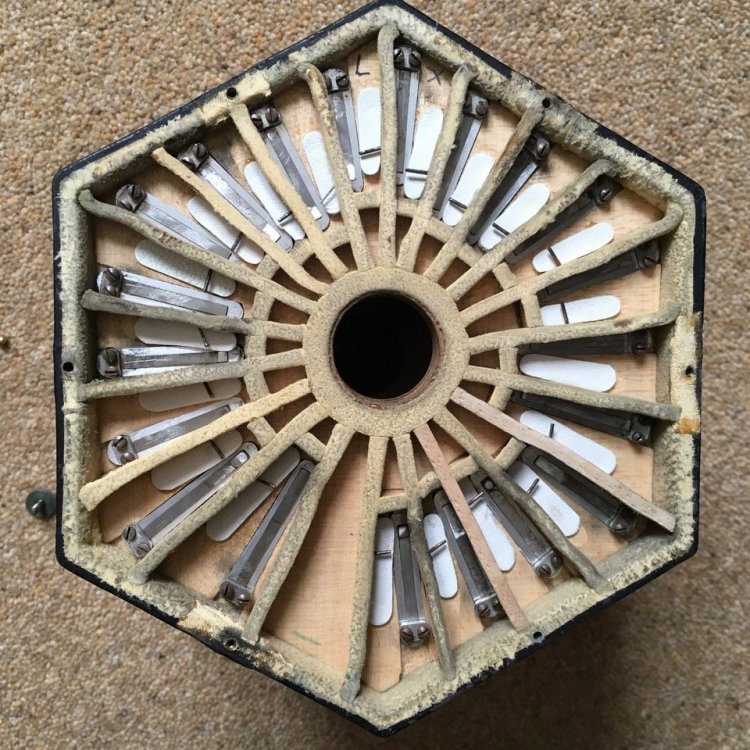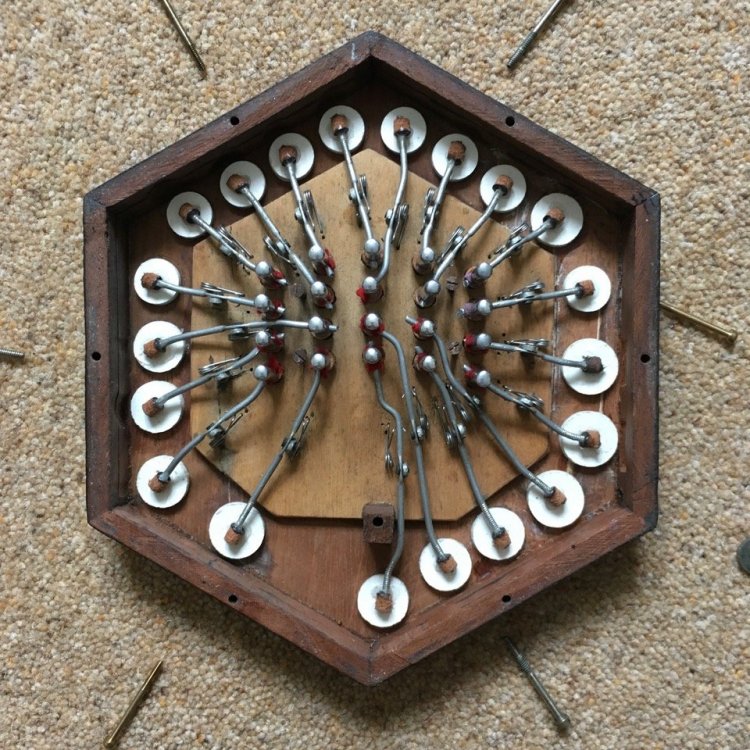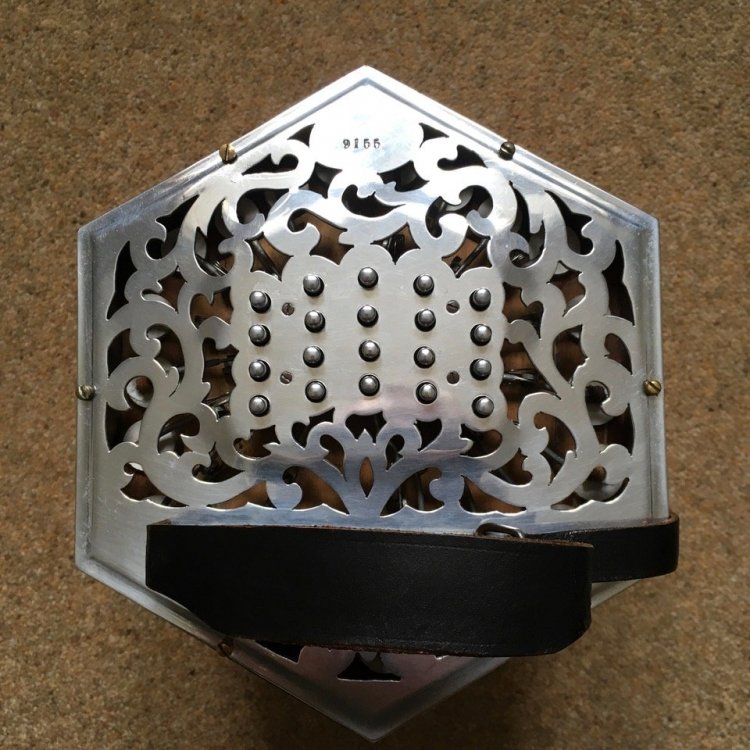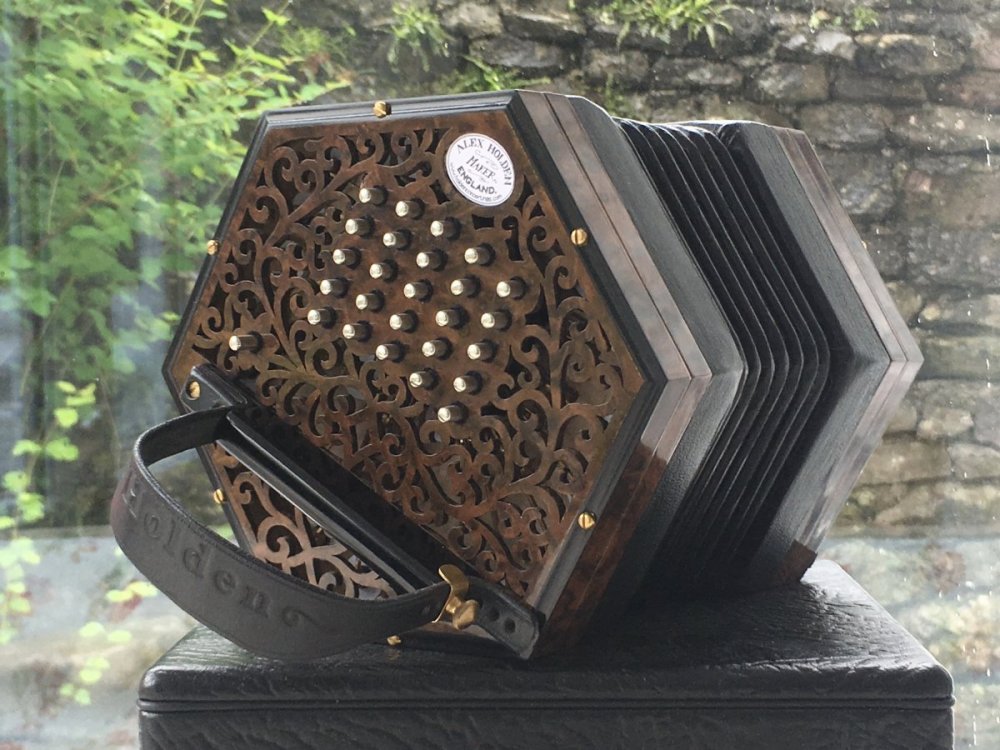-
Posts
556 -
Joined
-
Last visited
Everything posted by Little John
-
Actually it's no problem. The reeds are very efficient and the bellows capacious so I never use the air button in actual playing. I use it when I'm practising sometimes and want to repeat a long phrase or something like that, but not in performance. Indeed, I don't think much about the bellows. I seem to operate in the middle half of the bellows so if I suddenly come across a note that needs a push (say) when I would otherwise have changed to pull the remaining quarter of the bellows is more than enough to get me out of trouble. LJ
-
You'd have thought that if the bellows direction for the start made any difference, English and duet players would have cottoned on and exploited the effect. I've never heard it mentioned. Certainly, as a duet player, I can't think of a single tune that I don't start with a pull. That is simply because it seems natural - closed bellows is the starting position. There would have to be some obvious advantage to go to the trouble of opening the bellows wide before starting. LJ
-
I'm not sure I buy this. I've never been a "fast" player on any of the multitude of instruments I've played throughout my life. When it comes to concertinas I started on the English (and still occasionally play one), changed to Crane duet and tried Anglo reasonably seriously for a couple of years too. I'm faster on the Crane than I've ever been on the others; but that's mainly because it's the one I've played the most. It's down to how much practice you put in. In the past I've made the mistake of trying to keep two or three systems going at the same time. I now realise it would have been better to stick to one and just work at it. All systems have their advantages and disadvantages. Pick the one that seems to have the most advantages for what you want to do and work to overcome the disadvantages. LJ
-
Playing the melody on the right and some form of chord on the left is a perfectly reasonable way to start. It's hard enough to sing and play at the same time, let alone do something as complicated as playing a counter-melody (however simple) plus some left hand work. It sounds to me that your real problem is the volume. I've been there myself as a Crane player. 1. On some instruments the bass is simply too loud, so that even just playing (without singing) the bass overwhelms the melody. I've cured that to some extent on one instrument by fixing a leather baffle inside the fretwork of the left hand only, to obtain a better balance. 2. Irrespective of the overall volume, the reeds need to be set up so that they all speak at the same low pressure. It can be the case that the bass reeds speak more easily so that one has to play louder to get the melody reeds to speak. This is a vicious circle - as you play louder to hear the melody the bass gets louder too, so you play louder to try to hear the melody ... . Test this by holding down one button each side - say G3 on the left and B4 on the right with no pressure on the bellows then gently start to apply pressure. Try this with other note pairs. Which note sounds first? If it's always (or usually) the low one then you need to get the reeds re-set. A good instrument should be capable of playing both quietly and loudly. LJ
-
Most of us start with straps too tight and slowly loosen them, so I suggest you learn from others' experience and go for it right away! Three of my instruments have rests of 5/8" to 11/16"; the third has "ergonomic" rests where the highest point is 1". But it doesn't really make any difference because I don't rest my whole hand on the rest; only the back edge (little finger side) of the palm. The thumb side of the palm is about 1/2" above the rest and the thumb curls in to grip and tension the strap. So without altering the handrest you can curl your fingers comfortably over the buttons and play with the tip. If you need to move in an out a bit, say to give your little finger better access, you can pivot round the thumb end that's held agains the strap. LJ
-
Hi Howard, For real confusion try pairing Gathering Peascods with All in a Garden Green - the first four bars are identical! I do actually play this combination (solo) but I play the first in C and the second in G so there's some indication a change has taken place. LJ
-
I found this tune in the excellent Paul Hardy tune book, but dismissed it at first as being harmonically too dull. When I came back to it a couple of months later I realised this could be turned to an advantage - it lends itself to a drone-style accompaniment. I've used open fifths throughout. Looking for a tune to pair with it The Bonny Breast Knot came to mind largely because I had been learning it about the same time. The change in accompaniment lightens the feel and, combined with the change of key, marks a clear break between the two tunes; whilst the fact that the first note is the same as the last in Dr Faustus' Tumblers gives continuity. LJ
-
It's a phenomenon I've experienced too. I think it's more to do with the tonal quality of the sound. It's not just the concertina - a banjo will cut through too. At a recent folk festival I saw a morris side whose musicians consisted of several melodeons and a lone English concertina. From a distance the English shone through, but I bet the player herself felt as if she was drowning in a sea of melodeons. LJ
-
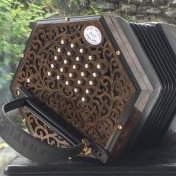
56 keys Tenor Treble English Concertina
Little John replied to mary-louise's topic in General Concertina Discussion
I agree; and an open fifth (or rather a succession of open fifths) held with one finger allows you to play a melody above it; but perhaps it's best to learn to walk before trying to run! LJ -

56 keys Tenor Treble English Concertina
Little John replied to mary-louise's topic in General Concertina Discussion
Using the root triads - the triangles shown in these diagrams - is a starting point, but rather limited. Two variations to consider, right from the start in my view, are: 1. Spread chords. Starting with the triad (triangle) as shown, take out the middle note and instead play it an octave higher (on the other side). Can often sound mellower than the basic triad. 2. First inversion. Starting with the triad as shown take out the bottom note and play it an octave higher (on the other side). These two techniques, along with the root triad, will allow you to play a more satisfying accompaniment where the top note of the chord (or the bottom note or even both) follow a musical progression. LJ -

My Reed Measurement activities
Little John replied to Seth's topic in Instrument Construction & Repair
I know this is off-topic, but ... The UK has still not "gone metric", thankfully. Some weights and measures were metricated, but we have all sorts of delicious exceptions and contradictions. Road distances are still measured in miles and yards, draught beer and cider is still sold in pints. In bottles it has to be metric, but what is 564ml if not a pint? Sheet building materials are still 8 by 4 feet (to line up with existing joist spacing), but the thickness is quoted as 13 or 19mm. And I'm sure most builders still refer to timber measuring 100mm by 50mm as "a bit of four by two". LJ -
Now sold. Usual donation made to this forum. LJ
-
This is a tune I tried to learn thirty odd years ago, but was defeated. I can't remember why, but I can guess. One thing is that it requires the B3 just below C4 (middle C). Since all standard Crane duets from 35 to 55 buttons start at C4 on the right that means picking it up on the left hand side - possible, but a bit of a nuisance. I overcame this in later years by re-tuning one C#4 reed to B3. The other reason was probably that the interval of a fourth, E5 - B4 on which it begins, is awkward for fingering. Over the years I've got more used to this sort of fingering; becoming quite flexible and no longer restricted by the one-finger-per-column approach which one naturally adopts to begin with. I might also add that the accompaniment would be quite limited without the B2 adaptation on the bass side, allowing a low B minor chord. (Standard Cranes start at C3 on the left.) The Holden Crane I'm playing has the B3 (right) and B2 (left) designed in from the start (along with Bb2 and A2, but those are not used in this recording). LJ
- 1 reply
-
- 5
-

-
I've owned this for about five years. Just over a year ago I had it serviced by Alex Holden, including new bushing boards and adjusting the button travel to make them uniform. It was also re-tuned to fifth comma mean tone. After that it became my "go-to" instrument. It's now surplus to requirements as I collected my new Holden 44 button Crane six weeks ago. Better it goes to a good home than gathers dust on my shelf! Photographs and button layout attached. You'll see that I have three buttons modified to extend the left hand down to A2 and the right hand down to B3. These were done professionally, weighting the reed tips with solder, so are easily reversible should you wish it. The raised metal ends, action and reed frames are all aluminium, making it a beautifully light instrument to handle. There are a number of recordings with it on my Instagram account. Here is one: To identify the other recordings on this concertina (all more recent than this) just look for the plain black bellows frames. I'm looking for about £1350. Buyer chooses carrier and pays postage. Includes a padded gig bag. Crabb 48 button Crane.pdf LJ
-
YouTube says the video is unavailable.
-

position while playing effecting tuning
Little John replied to LateToTheGame's topic in General Concertina Discussion
That's right. If the Dipper was tuned to be in pitch at a reasonably high volume then it would be slightly sharp (if anything) at low volume. Maybe the "pros" could detect it was out of tune but mistook sharp for flat. Or maybe they were just having a laugh! LJ -
I suggested I might need a taller hand rest on my new Alex Holden instrument. In the end it is the same height as the old one and it doesn't matter. I think the shorter button travel achieves the same effect as having a taller rest. In any event, this new instrument is extremely easy to play. [Pinky / pinkie - I don't think it matters. In either case the plural would be "pinkies" by the curiosities of the English language!] LJ
-
A slant that brought the buttons closer to the little finger would do that, but the Hayden slant does the opposite - it takes the buttons nearest the little finger furthest away. LJ
-
Some people on some systems seem to prefer not to use their little fingers (pinkies). I play Crane and was inclined that way at first (probably because I came to it from the English), but in the end found it was much better to train myself to use my little fingers. Looking at the note chart for the Hayden I don't see how you could play a scale smoothly without using your little finger - there's always a point where it requires four buttons consecutively in the same row. So if I were thinking to play a Hayden I'd go for the layout that allowed easy use of all four fingers. LJ
-
It is, indeed, a lovely tune. Far be it from me to argue with the mighty JK, but this version seems to be closer to Idbury Hill (Bledington) than the Longborough tune. The Black Book also gives an Oddington dance of the name London Pride, but no tune. However, neither Idbury Hill nor London Pride have "slows", so JK must have invented the C music! LJ
-
Looks like a chevron to me! Have you measured it?
-

Hayden duet that favors flat keys?
Little John replied to Aldon Sanders's topic in General Concertina Discussion
Well, if you were playing just on your own the obvious answer would be to transpose up or down a semitone to a playable key. (E.g. change Db to either C or D). But would this be too difficult for the rest of the orchestra? LJ -
So here it is! My new Holden Crane. It's described in detail on Alex's blog so I won't repeat it here. You'll also find on his blog a medley of tunes. They were recorded only minutes after I'd made the instrument's acquaintance and I was just playing whatever came into my head, so you'll have to forgive a few slips. I've actually had this for a while, but I collected it from Alex on my way to a long holiday so I've been unable to post anything until now; which is probably a good job as I'd have just gushed with enthusiasm for my new acquisition. Instead I've had a fortnight to give it a thorough work-out so I'm able to give a much more considered assessment: this is, quite simply, the best duet I've ever played*. The bellows are supple: no need to "break them in" - they were as flexible as you could wish from the outset. Capacious too - I can play long passages in one direction even using a lot of heavy chording. The reeds are very sensitive. They respond evenly and quickly at very low pressure, so that one can play really quietly but still maintain crispness. They also have a wide dynamic range, so plenty of volume when you need it. This means I can play quietly to sing against then ramp up the volume for a musical interlude. The balance is also excellent. A frequent (almost ubiquitous) complaint of duets (and to some extent anglos) is that the lower notes can overpower the high notes. That's not the case with this one. Certainly from my position as the player (and that's usually the worst position!) the melody never gets lost. Tone is a subjective matter, and Alex generally prefers not to describe the sound of his instruments. I would probably say it sounds "solid and full". Others who have heard the recordings have said variously "what a brilliant rich sound", "very nice, full and open sounding", "marvellous sound ... I very much like the bass side", "Wow! Even on the phone this sounds lovely!" Alex, despite his usual reticence, says in his blog "I am really happy with how rich and well balanced it sounds (even more so in person than recorded on a built in phone mic)". Finally, as a general point, it's really easy to play. The light weight and the lightness of the action contribute to that, but I think it's the result of several factors working together that make it so. I've had the concept of this instrument for many years, and Alex has translated it perfectly into a reality. Having played it for hours, day after day, I can find no fault with it and there's nothing I would change about it. LJ *Possibly the best concertina I've ever played too, but a strong contender for that would have to be the special English built by C&R Dipper which I sold about fifteen years ago when I realised I had neither the time nor the talent to be proficient on two different systems.
-

My experience with 1/5 comma mean tone tuning
Little John replied to Little John's topic in General Concertina Discussion
It depends which accidentals you have on your instrument. If you have and Ab then Ab major should sound good (Ab - C - Eb), but if you haven't (which is probably the case) and have to use G# instead then it will indeed sound awful. G# major will sound awful because the third will be C instead of B#. LJ -

My experience with 1/5 comma mean tone tuning
Little John replied to Little John's topic in General Concertina Discussion
I don't know about just temperament, but in mean tone tuning all whole tone intervals are the same as long as you don't step over the break in the circle of fifths. So in my case C# to Eb and G# to Bb would be much wider than the rest. They would probably be tolerable in a melody and they wouldn't crop up in harmony, so it's not that big a problem. Thirds and fifths are where the real problems lie. LJ



